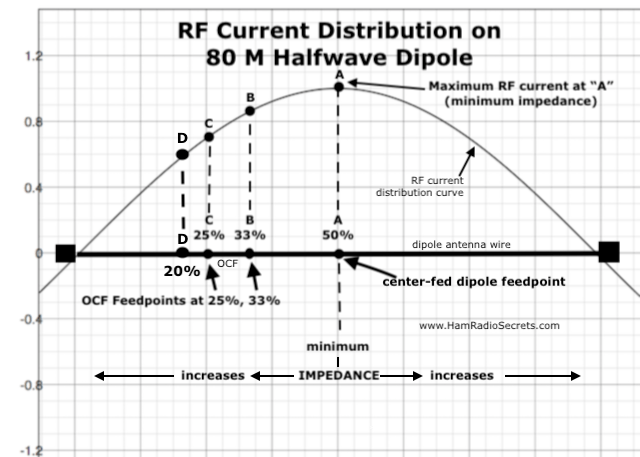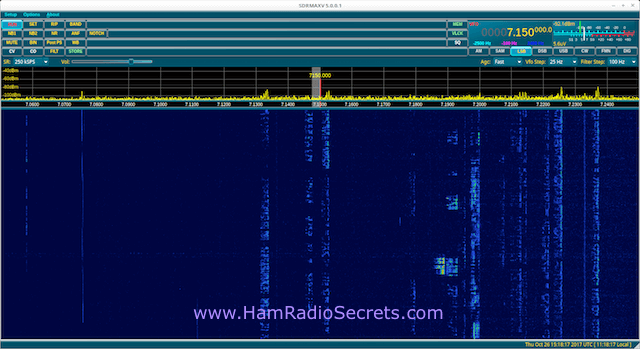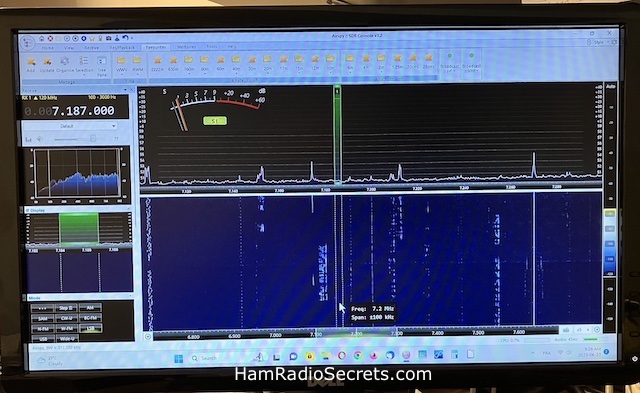My Homemade Multiband HF Fan Dipole Antenna
by Robert Ewers K9HOU
(Spring, Texas, U.S.A.)

Fan dipole hoisted up its mast
My stacked dipole worked great on 10, 15 & 20 meters but when I tried adding a 40-meter element, it was too big. (See reference at the end of this article)
Wanting to be able to work on 40 meters, I decided to take the 40 ring off the stacked dipole and add a simple 40-meter dipole to the 50-foot wide back yard, in my HOA lot.
I had to take down my 2 meter/70 cm antenna on top of a 20 foot of PVC pipe due to the next-door neighbor replacing the fence between our yards.
I moved the 20-foot PVC mast to the center of my yard and added a small pulley to the top of it. I ran a Dacron rope through the pulley.
I painted the PVC to a dull dark gray, so that it would not be too visible in my HOA.
I flattened the center of an 8-inch length of 1/2 aluminum tubing, drilled two holes in the flattened area and screwed to the bottom PVC pipe about 4 feet above the bottom to work as a cleat, like a boat cleat. I can tie my rope, halyard, to it when I raise the antenna.
I still had a pair of wires cut for 40 meters. I also had pairs for 10 and 20. I made a pair for 15 meters with some other used wire that I had. Wires are all #14 AWG stranded with a black jacket.
I cut spreaders out of some lengths of 1/2 inch PVC:
2 pairs of 10 inch long spreaders
1 pair 6 inches long
1 pair 3 inches long
I drilled evenly spaced holes on the spreaders and ran the wires through the holes. I added a tie wrap around the PVC and wire to secure them in place.
Each pair of antenna wires had a ring terminal installed at one end for connection at the fan dipole feedpoint. The wires were matched together to be the same length on each band. This is a must as the two elements must be balanced.
I installed a 10-inch PVC spreader near the center to spread and arrange the elements: lowest band (40 meters) on top, shortest wire (for the 10-meter band) on the bottom!
The second 10-inch PVC pipe spreaders are positioned near the end of the shortest wire (10 meters). The rest of the supports are placed near the end of the remaining wires for 20 and 15 meters.
My longest wires (for the 40-meter band) are each almost 33 1/2 feet long, for a total antenna span of 67 feet... in a 50-foot wide back yard!
Obviously, the fan dipole antenna will have to be configured as an inverted 'V' if it's going to fit.
I installed two 10-foot 3 inch PVC pipe masts at the far corners of the yard. Each had holes through near the top. The 40-meter antenna wire was passed through the top secured with a tie wrap around the pipe and left to hang down outside for the ease of tuning - then allowed to hang inside the pipe after trimming. If you have the room then the ends can be connected to a ground tie down. Make sure to use an insulator on the end of the wire. Rope will get wet with rain or dew and your rope can catch fire or melt. Not good.
I raised the antenna up while taking care that wires were not tangling up which would cause problems. You will most likely have to raise the fan dipole several times to adjust the spreaders. I put a tie wrap around the coax and mast loosely to keep the coax from pulling the mast to one side.
Now with the coax connected to the shack, I got busy with the antenna analyzer to check how I had done so far.
The Feedpoint Assembly
I constructed a special feedpoint assembly for the fan dipole.
I took a 1-inch PVC pipe about 7 inches long and two 1/2 inch aluminum tubing of the same length. I drilled through each end of the tubing and into the PVC to be able to attach the tubing to the PVC acting as a center insulator. I drilled four more holes evenly spaced for self-tapping screws to hold the four elements spread out on each side. Three larger holes for the coax on one end and a single hole at the other to attach the rope (halyard) to the top end.
NOTE on Finding Proper Antenna Dimensions
I made my wires about 6 inches too long to make pruning (tuning) easier.
I also like to use - http://www.westmountainradio.com/antenna_calculator.php - to help find the length of wire on each side of the dipole, for each band.
For each band, enter the frequency you want your antenna to resonate at into their calculator. It will tell you what the length of the wires should be at that frequency.
OR... you can use an antenna analyzer to find what frequency your antenna wires resonate at. If a dipole resonates too low, then the wires are too long and will have to be trimmed down - carefully, a few inches at a time on each side of the dipole - then test again with your antenna analyzer, until you have the proper length. Repeat this procedure for each dipole (band).
I found crimp type but splices are fine if you need to add to the ends when your antenna resonates too high in frequency.
After adding and cutting, the antenna was OK.
After making adjustments, my highest SWR is 1.6:1.
For more pictures about this multiband fan dipole antenna, click HERE.
73 de Bob K9HOU
Reference
See my other article describing my vertical multiband HF dipole.
Return to Ham Radio Antennas Rave Accounts.
73 de VE2DPE
Claude Jollet
104-30 avenue des Berges,
Notre-Dame-des-Prairies, Québec, Canada J6E 1M9
QTH Locator: FN36gb
Disclosure
If
you make a purchase via a link on this site, I may receive a small
commission on the transaction, at no extra cost to you. Thank you!
(One word queries work best)
FOUND THIS
SITE
USEFUL?
VE2DPE
Is a member
in good standing
of
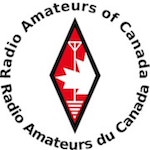

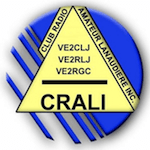
Also a proud member of an international community of solopreneurs
using SoloBuildIt!
(SBI!)
to promote my self-published eBooks
since 2005.
See my review
of this unique product for online businesses.
CQ CQ CQ
If you have a question, a comment or a topic you would like me to cover, please do not hesitate to ask here.







